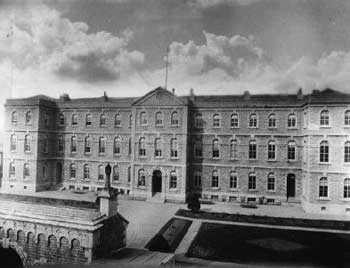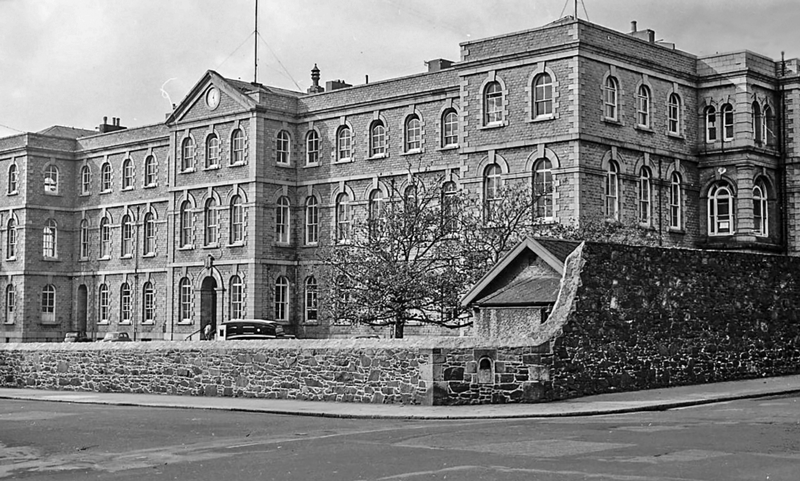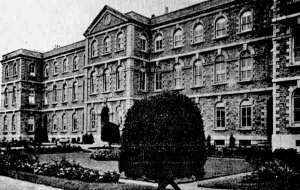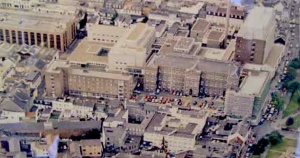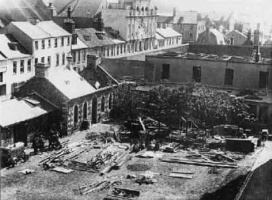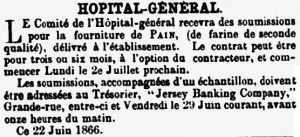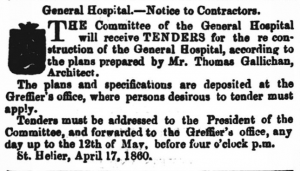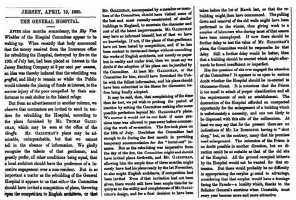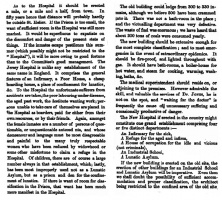Jersey's main hospital, known as the General Hospital, was built on a site stretching from the Parade to the sea, and bounded by Gloucester Street, in the mid-18th century. The building was not at first intended to be a hospital, but a poorhouse, and its original benefactress had wanted it built at Saint Aubin.
Marie Bartlett
In 1741 Marie Bartlett, née Mauger, bequeathed to the public a sum of money for the construction and maintenance of a new poor house or hospital. The hospital was to be sited at St Aubin and Mrs Bartlett, together with her husband Francis, had acquired a plot of land there for this purpose. It was later disposed of by the administrators of the hospital.
Delays occurred before the provisions of Mrs Bartlett's will could be carried out and the States decided that the location at St Aubin was unsuitable and that the new hospital should be built in St Helier, which was becoming the island's main town.
According to records a plot of land on the common to the west of town was chosen and ceded to the public by the then Seigneur of the fief, Philippe Bandinel. The foundation stone was laid in 1765.
But the marvellous new building was coveted by successive military commanders to accommodate garrison troops in the absence of any barracks, and in 1779 it was requesitioned by General Conway. Four years later two-thirds of the building was demolished when gunpowder exploded and it took five years before the British Government paid the £2,000 needed to rebuild. It was not until 1793 that the poor of the island finally took possession of their rebuilt home.
Fire
Another 66 years went by before the Hospital was severely damaged by fire in 1859. The following report was contained in the Illustrated London News
- "On the night of Monday, the 18th ult, the General Hospital, Gloucester Street, Jersey, was almost totally destroyed by fire. At about half-past eleven smoke was perceived issuing from the roof, followed shortly after by flames. The inmates and servants of the establishment had all retired to rest, and it was with difficulty that they could be aroused. The first thought of Mr. Arthur, the governor, was to provide for the safety of the three hundred inmates who occupied the building; and, with the help of the servants and of several persons brought to the spot by the cries raised in town, the whole of the invalids were removed in safety. The "worst cases" were conveyed to the outhouses, but the greater part congregated in the garden, where they were supplied with blankets and other articles of covering.
- "A large portion of furniture, bedding, and other effects were saved, as were likewise the portrait of the founder of the establishment, the record, and other valuable documents. Meanwhile the fire had made rapid progress, and had spread along the entire length of the roof, descending into the upper story. Several fire-engines were shortly brought on the spot, but the fire spread with great rapidity in its downward course. From the first moment it was evident that the main building was doomed, and, consequently, the efforts of those employed were directed to protect the two wings, which had still remained intact. The communications were thereupon cut off, and the engines worked manfully. In a short time it was perceptible that the great body of water poured in at the gables had made an impression on tho fire. At about five the fire was mastered, and all further apprehension had ceased. Happily, no lives were lost, nor did any accident of a serious nature occur."
Transactions
In the mid 1700s the Pauvres de cette Ile transacted on behalf of the hôpital général and some transactions were registered under the names of the executors of Marie Bartlett's will, who were described as "trustees" for Les Pauvres de cette ile. James Pipon was the surviving executor in the 1760s.
By the early 1800s the contracts were passed under the name of l'Hôpital Général, rather than the Public or States of Jersey.
The land between what is now the hospital and the beach (the site of Patriotic Street, Patriotic Place, the multi-storey car parki and Century Buildings, etc, was also originally part of the hospital property. Representatives appointed by the States on behalf of l'Hôpital Général sold this area of land to Jean Dolbel by contract dated 14 April 1810 and retained the site of Newgate Street and the Hospital to the north of the land sold.
The hospital premises were extended towards the north-west during the 1970s and '80s on to land acquired by the Public as follows:
- Parade Rope Walk, acquired from John William Huelin by contract dated 19 September 1908
- Various properties in Kensington Place, including Margarita Lane, Parade Place and Kew Cottages, by contracts of purchase dated between 1964 and 1978.
Gwyneth Huelin Wing was constructed on the site of the former Newgate Street Prison, which in turn was originally built in the grounds of the Hospital.

Further articles
- Marie Bartlett, the founder of the hospital
- Ambulance Service
- St Saviour's Hospital
- Some hospital records Added 2016
- Jersey Asylum for Infirm and Aged Women Added 2022
- Private lunatic asylum for paupers Added 2022
Art collection
The hospital has a small art collection which features in the Your Pictures project.
Click on any image to see a full-size version
Gallery
Click on any image to see a full-size version
A photograph taken by Albert Smith in about 1930

Other hospitals
Newspaper articles
Some cuttings of newspaper articles relating to the hospital. Click on image to enlarge to readable size
